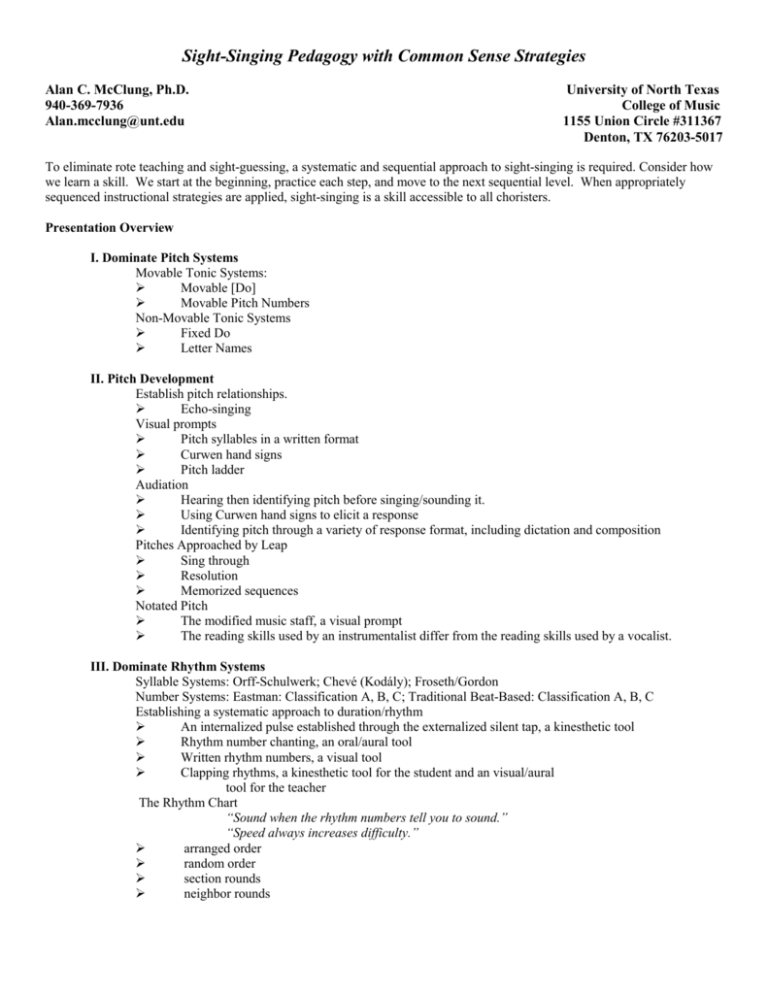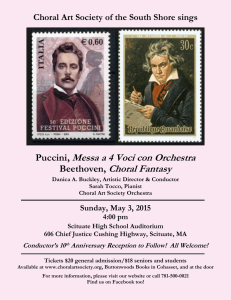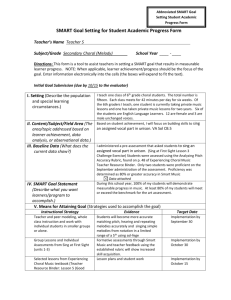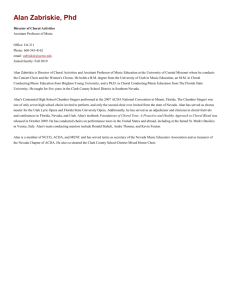Overview of Common Sense Strategies
advertisement

Sight-Singing Pedagogy with Common Sense Strategies Alan C. McClung, Ph.D. 940-369-7936 Alan.mcclung@unt.edu University of North Texas College of Music 1155 Union Circle #311367 Denton, TX 76203-5017 To eliminate rote teaching and sight-guessing, a systematic and sequential approach to sight-singing is required. Consider how we learn a skill. We start at the beginning, practice each step, and move to the next sequential level. When appropriately sequenced instructional strategies are applied, sight-singing is a skill accessible to all choristers. Presentation Overview I. Dominate Pitch Systems Movable Tonic Systems: Movable [Do] Movable Pitch Numbers Non-Movable Tonic Systems Fixed Do Letter Names II. Pitch Development Establish pitch relationships. Echo-singing Visual prompts Pitch syllables in a written format Curwen hand signs Pitch ladder Audiation Hearing then identifying pitch before singing/sounding it. Using Curwen hand signs to elicit a response Identifying pitch through a variety of response format, including dictation and composition Pitches Approached by Leap Sing through Resolution Memorized sequences Notated Pitch The modified music staff, a visual prompt The reading skills used by an instrumentalist differ from the reading skills used by a vocalist. III. Dominate Rhythm Systems Syllable Systems: Orff-Schulwerk; Chevé (Kodály); Froseth/Gordon Number Systems: Eastman: Classification A, B, C; Traditional Beat-Based: Classification A, B, C Establishing a systematic approach to duration/rhythm An internalized pulse established through the externalized silent tap, a kinesthetic tool Rhythm number chanting, an oral/aural tool Written rhythm numbers, a visual tool Clapping rhythms, a kinesthetic tool for the student and an visual/aural tool for the teacher The Rhythm Chart “Sound when the rhythm numbers tell you to sound.” “Speed always increases difficulty.” arranged order random order section rounds neighbor rounds IV. Combining Duration and Pitch Finding [Do]. Less is more! The flat farthest to the right is always [Fa] The sharp farthest to the right is always [Ti]. Isolate pitch, isolate rhythm, then combine Minor Scale [La]-based minor, the prevalent approach [Do]-based minor Chromatic Scales Selected References Bloom, B. S., Englehart, M. C., Furst, E. J., Walker, H. H., & Krathwohl, D. R. (1956). Taxomony of educational objectives: The classification of educational goals - handbook I : Cognitive domain. New York: David McKay Company, Inc. Choksy, L. (1988). The Kodály method: Comprehensive music education from infant to adult (2nd ed.). Englewood Cliffs, NJ: Prentice Hall. Demorest, S. M. (2001). Building choral excellence: Teaching sight-singing in the choral rehearsal. New York: Oxford University Press. Gordon, E. E. (1997). Learning sequences in music: A music learning theory. Chicago: GIA Publications, Inc. McClung, A. C. (2001). Sight-singing systems, current practice, and a survey of all-state choristers. Update, 20, 3-8. McClung, A.C. (2008). Movable Tonic: A Sequenced Sight-Singing Method. Chicago: GIA Publications, Inc. McClung, A.C. (2008). Sight-singing scores of high school choristers with extensive training in movable solfège syllables and Curwen hand signs. Journal of Research in Music Education, 56 (3), 255-266. Norris, C. E. (2004). A nationwide overview of sight-singing requirements of large-group choral festivals. Journal of Research in Music Education, 52 (1), 16-28. Varley, P. C. Jr. (2005). An analysis of rhythm systems in the United States: Their development and frequency of use by teachers, students, and authors; A relation to perceive learning preferences. Dissertation Abstracts University of Missouri-St. Louis. Alan C. McClung joined the University of North Texas College of Music faculty in 2002. He directs UNT’s Up Front (a 75 voice laboratory choir for choral music education), teaches undergraduate choral conducting, courses in secondary choral methods, and supervises student teachers. He holds a BMED from West Virginia University, a MM in Choral Conducting from the University of Illinois, Urbana/Champaign; and a PHD in Music Education from Florida State University. Dr. McClung's professional experience includes teaching and conducting at all levels. In addition to six European concert tours, noted performances of his middle, upper, and college choirs include invited performances for the Missouri Music Educators' State Conference, Louisiana Music In-Service Conference, Georgia Music Educators' State Conference, ACDA-Southern Division Convention; and a special Symphony Hall collaboration between his Woodward Academy choirs and the Atlanta Symphony Orchestra. He has conducted a variety of state and region honor choirs and has served as guest conductor for the award winning Landesjungenchor from Koblenz, Germany. As chorister and soloist, Dr. McClung spent three seasons singing with the Atlanta Symphony Chorus and Chamber Chorus under the direction of Robert Shaw. An active member of ACDA and NAfME, he has served as a national delegate to ACDA's International Conductor Exchange with Germany and Sweden, Georgia's ACDA Repertoire and Standards Chair for High Schools, Georgia Music Educator’s State Choral Chair, Missouri's ACDA Repertoire and Standards Chair for Colleges and Universities, and the R & S Chair for Southwest ACDA’s Student and Youth Activities. As a distinguished choral music educator, he is invited frequently to present at state, divisional, and national music conferences. Additional presentations include master classes at Roehampton University, London, England. Articles by Dr. McClung have appeared in Southeastern Journal of Music Education, ACDA's Choral Journal, MENC's Music Educators Journal, Update: Applications of Research in Music Education, and Journal of Research in Music Education. He is the author of Movable Tonic: A Sequenced Sight-Singing Method, a GIA publication and director of the Cambiata Institute of America for Early Adolescent Vocal Music. A UNT Honors Professor, he was recently named the new managing editor of Cambiata Press, a publication company dedicated to the changing voice. On May 6-7, 2016, he will facilitate the 3rd MS/JH National Conference for Choral Music: www.music.unt.edu/cambiata.





